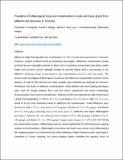| dc.description.abstract | Maize is a major food security crop contributing over 50 % of total food requirement in Tanzania. However, number of factors limit its production and quality. Aflatoxins contamination mostly produced by two Aspergillus species, A. flavus and A. parasticus compromise food safety, public health and economic concern globally. Despite its harmful effects little is documented on the aflatoxin- producing fungi on prevalence’s and contamination levels in soils and maize. The present study investigated Aflatoxigenic occurrence and aflatoxins contamination extents in seven districts. A total of 126 soil and 126 maize samples were collected and analyzed for presence, dominance, and levels of aflatoxin contaminations. Serial dilution and direct plating techniques were used for fungal isolation from soil and maize respectively and macro morphology characterization were used for identification. Aflatoxin levels were detected by High-Performance Liquid Chromatography. A. flavus (38.1 %), A. parasiticus (22.2 %) and A. niger (16.7 %) were found to be the most dominant linked to aflatoxins B1 contamination. Total Aflatoxins were detected in Bahi (72.2 %, with mean of 87.9 μg/kg), Chemba (61.2 %, 74.2 μg/kg), and Babati (56.3 %, 65.8 μg/kg) indicating these were more prone to aflatoxins and higher aflatoxigenic prevalence. Aflatoxin B1 was detected most in Bahi (22.4 %, 402.4 μg/kg), Chemba (13.4 %, 241 μg/kg), and Babati (11.1 %, 199.2 μg/kg). Fungal counts ranged 3.4 ×105 to 6.9 ×107 CFU/g for contaminated samples. Aflatoxigenic species varied significantly (P<0.001) between cropping systems and the locations. Aflatoxigenic occurrence and levels were shown to be influenced by the cropping systems, as evidenced by the soils exhibiting a higher frequency than maize grains. Compared to mixed cropping, the mono-cropping system exhibited the greatest levels of aflatoxigenic population and aflatoxin contamination, indicating that farming practices affect contaminations and the need for improved cropping system practices. | en_US |

